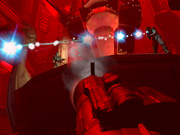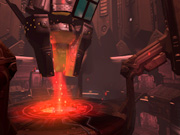Doom 3 Multiplayer Hands-On Impressions
We spend some time with Doom 3's deathmatch multiplayer mode.
Surprisingly, the highlight of QuakeCon 2003 isn't its new venue at the fabulous Adam's Mark Hotel in Dallas (moved from the event's traditional home in the neighboring city of Mesquite), but rather, a playable version of the multiplayer component from id Software's highly anticipated first-person shooter sequel Doom 3. We were able to jump in for a few rounds of head-to-head deathmatch play, though the graphically impressive shooter will also support other multiplayer modes, including team deathmatch. However, the developer has stated previously that it has focused most of its efforts on Doom 3's single-player game, which will make use of id's powerful new game engine and its ability to render impressive real-time shadows and portray its characters with extremely high polygon counts and realistic physics. So we were intrigued when we heard that Doom 3's multiplayer would be on hand at QuakeCon, especially since the game's extremely high-end graphics seem like they'd be restrictive in large-scale multiplayer matches with lots of character models onscreen at once, and since many of the game's levels will be dark, tightly enclosed areas designed to induce claustrophobia.

The level we played took place in a futuristic starbase into which demonic influences had just begun to encroach--this influence was represented by a few specific areas of the otherwise sleek, high-tech base being covered by a pulsating, fleshy mass. We played a few sessions of four-player free-for-all deathmatch in this small level, whose layout seemed a bit reminiscent of a few of the smaller deathmatch maps in Quake III. The two-level map was set around a gigantic, churning reactor whose center had apparently been corrupted by demons, such that falling through it would churn you through a swirling red portal and teleport you to another part of the map.
The center of the portal also housed the "berserk" power-up item, which, just like in the original Doom, lets you completely obliterate your enemies with a single punch. Considering that many of Doom 3's levels will be more tightly knit (and offer less room to run away) than the larger levels of Doom II, berserk seems much more dangerous, which is apparently why it's also so obvious. Picking up the berserk item causes your character to briefly go insane--you still have complete control of your character, but your screen flashes red, like in the original Doom games, and your character screams at the top of his lungs (which is audible from a distance) and is surrounded with glowing red rings.
Still another reason why the berserk item seemed more effective than, for instance, using the close-range gauntlet weapon with the quad damage item in Quake III Arena, is that, as id Software CEO Todd Hollenshead explained, Doom 3 features per-polygon hit detection, rather than the typical Quake II/Quake III system of using an invisible bounding box for hit detection. Though the run speed in the multiplayer games we played didn't seem especially fast, it was more than adequate to dodge incoming fire from our opponents, especially around the map's tight corners. Close-quarters battles seemed to get especially tense at times because of the game's disorientation effects, which cause your onscreen vision to blur if you take a direct hit from an enemy weapon--especially a point-blank blast from the shotgun, which not only blurs your view considerably, but also briefly jolts the screen.
Knee-Deep in Deathmatch
In terms of weapons, the Doom 3 map we played on featured a few old standbys from the original Doom games, including the plasma rifle and the rocket launcher, as well as a combat shotgun and a new machine gun. We were able to pick up and use these weapons in addition to the default weapons we started with--the pistol, our fists, and the flashlight item, which helps you see in the dark (though it also makes you clearly visible to other players) and can also be used as a blunt weapon in a pinch. All the weapons obviously had sleek new weapon models that put the original Doom weapons to shame, but we didn't get much of a chance to try out the plasma rifle ourselves, especially since the default pistol was so underpowered that we'd often run for a shotgun or the rocket launcher, which was hidden on the second level of the reactor.

The shotgun seems like an extremely effective weapon that is decent at a distance and devastating up close. Since Doom 3 uses per-polygon hit detection, we didn't fare as well with the rocket launcher, though aiming at our opponents' feet, as Hollenshead advised, netted us a few frags. In fact, getting a solid hit on an enemy caused him to be launched in the air, and if he happened to die from the damage, his body would flop down across the ground using the game's rag-doll physics. Naturally, since we were playing the game against fellow members of the press, we were all stopping frequently to note different features of the game and look at the scenery, which included an infested hallway with a human torso hanging from the ceiling (shooting it actually caused it to sway back and forth using rag-doll physics), so not everyone was trying very hard to win.
We did find that classic deathmatch skills, such as good aim, avoiding enemy fire, and controlling the most powerful weapons and armor on the map, helped us come out on top more often than not, so Doom 3 will definitely have something to offer hard-core deathmatch fans. The level even had several interactive elements, such as small crates that could be pushed or shot about, elevator lifts that could be triggered by approaching closely and pressing the fire key, and light switches that could be used in a similar fashion. Flipping switches requires you to get extremely close to the switch, which causes you to lower your weapon so you can use it safely. So, obviously, a sloppy attempt to use a switch while carrying a rocket launcher in a frantic deathmatch could result in you blowing your own head off.
The switches themselves often play a role in the gameplay. As Hollenshead explained, one of the most obvious and effective tactics in a Doom 3 deathmatch is to stake out a room with a light switch, kill the lights, and lie in wait. Then, when someone else happens to blunder into the room and hit the lights, you can blast him to bits. Even Doom 3's impressive real-time shadows play a role in deathmatches--in many corridors with sparse lighting, your shadow will either follow or precede you, and it can give away your position even if you're trying to hide. As designer Robert Duffy explained, creating Doom 3 maps is an arduous task that involves not only laying out each level's geometry, but also tweaking, twisting, and shifting objects in and around each level's light sources to create shadows that are suitably menacing.
Though it doesn't seem revolutionary at this point, Doom 3's deathmatch seems extremely playable. However, we played the game on high-end PCs equipped with Nvidia's GeForce FX 5900 cards, and the demonstration ran at 640x480 resolution with only four players. How well the game will support larger multiplayer sessions, especially at higher graphical settings, remains to be seen. And there's the matter of the single-player game, which we haven't seen much of yet outside of officially released trailers. Doom 3's release was recently delayed until 2004, but we'll have more updates on the game as soon as we can.
Got a news tip or want to contact us directly? Email news@gamespot.com
Join the conversation